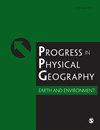古滑坡区植被丰富度的景观级研究
IF 3.6
3区 地球科学
Q2 GEOGRAPHY, PHYSICAL
Progress in Physical Geography-Earth and Environment
Pub Date : 2023-10-14
DOI:10.1177/03091333231206314
引用次数: 0
摘要
滑坡作为维持生物多样性的一种重要的自然干扰受到了广泛的关注,但以往的研究大多集中在几年或几十年的演替的早期阶段,地点或小流域。本研究旨在确定区域驱动因素对日本山区大型古滑坡陡坡长期生态演替的影响。利用GIS对993个滑坡坡面进行景观级分析,发现气候因子尤其是降雪是影响该地区滑坡坡面植被发育的重要区域驱动因素。虽然古代滑坡陡坡上的植被已经发育,但即使经过数百年或数千年的时间,并不是所有的陡坡都能恢复到滑坡前的植被状态。植被类型数与最大雪深的关系表明,在最大雪深小于100 cm的区域,一种植被覆盖的滑坡陡坡比例大于50%,且随着积雪的增加,一种植被覆盖的滑坡陡坡比例减小。积雪越深,滑坡陡坡上的植被类型越多。由于大雪导致森林植被无法生长,因此在山崖上形成了草甸、草地和灌木地。结果表明,滑坡干扰和气候因素的共同作用导致了区域植被类型的多样性。本文章由计算机程序翻译,如有差异,请以英文原文为准。
A landscape-level study on vegetation richness of ancient landslide areas
Landslides have received significant attention as an important natural disturbance that maintains biodiversity, but most previous studies have focused on the early stages of succession during years or decades in sites or small watersheds. The present study aimed to determine what regional drivers influence long-term ecological succession in large, ancient landslide scarps across a mountainous region in Japan. A landscape-level analysis of 993 landslide scarps using GIS revealed that climatic factors, especially snowfall, are important regional drivers of vegetation development on landslide head scarps in the region. While vegetation has developed on ancient landslide scarps, not all of them have returned to their pre-landslide vegetation state even though hundreds or thousands of years may have passed. The relationship between the number of vegetation types and maximum snow depth shows that where the maximum snow depth is less than 100 cm, more than 50% of the landslide scarps are covered by one type of vegetation, and the percentage of scarps covered by one type of vegetation decreases with increasing snow cover. The deeper the snow, the more vegetation types tend to develop on the landslide scarps. Since forest vegetation cannot develop due to heavy snow, meadows, grasslands, and shrublands are found on the scarps. It is concluded that the combined effects of both landslide-caused disturbances and climatic factors are creating regional diversity in vegetation types.
求助全文
通过发布文献求助,成功后即可免费获取论文全文。
去求助
来源期刊
CiteScore
7.20
自引率
5.10%
发文量
53
审稿时长
>12 weeks
期刊介绍:
Progress in Physical Geography is a peer-reviewed, international journal, encompassing an interdisciplinary approach incorporating the latest developments and debates within Physical Geography and interrelated fields across the Earth, Biological and Ecological System Sciences.

 求助内容:
求助内容: 应助结果提醒方式:
应助结果提醒方式:


